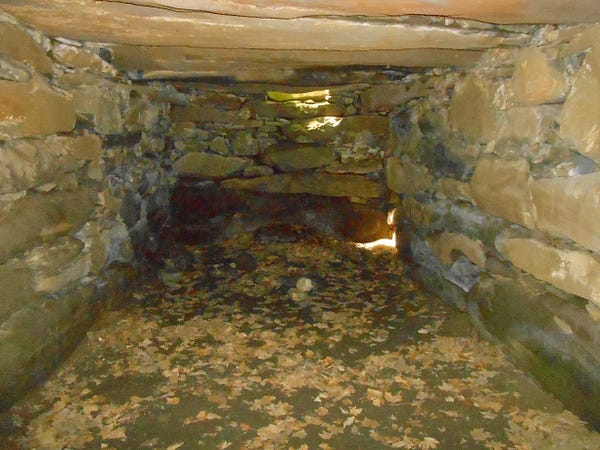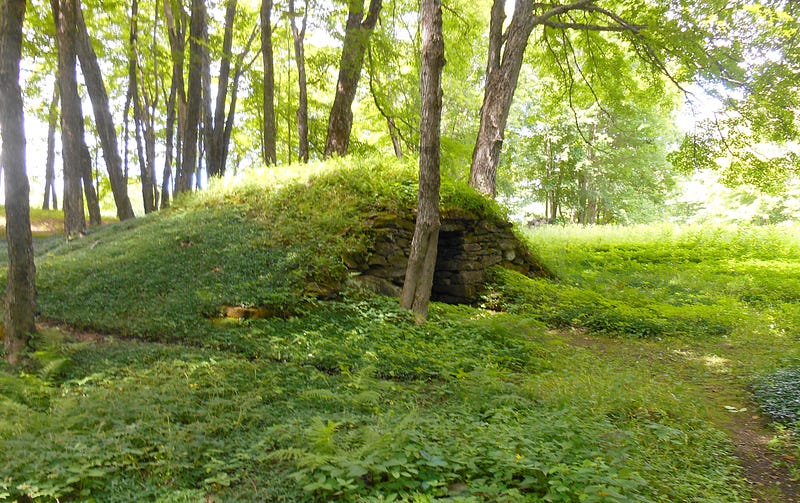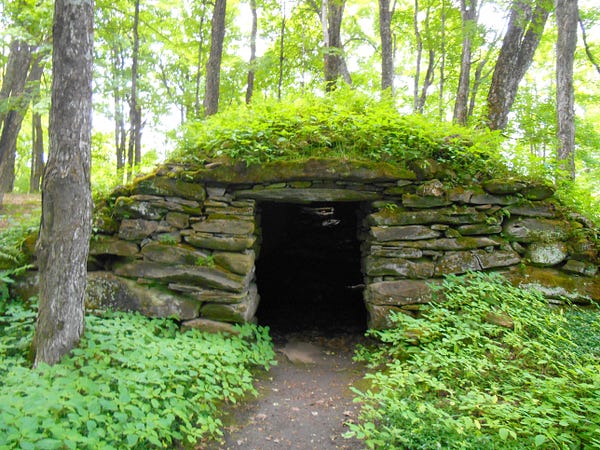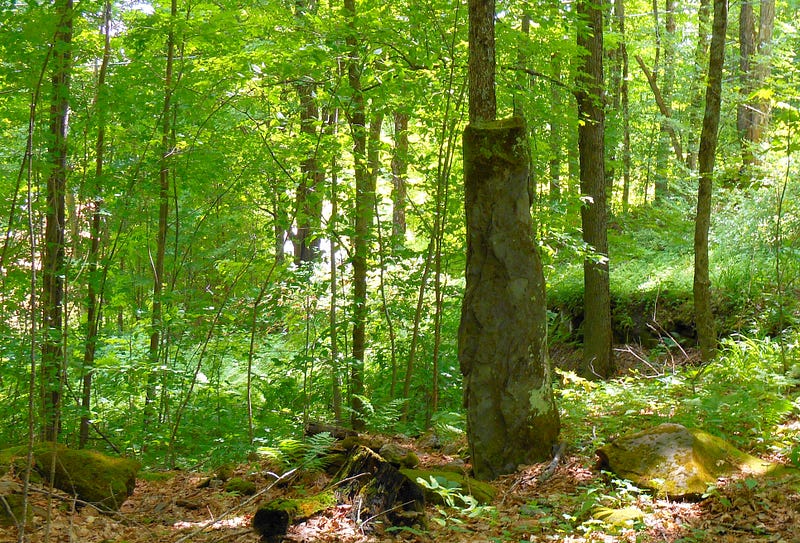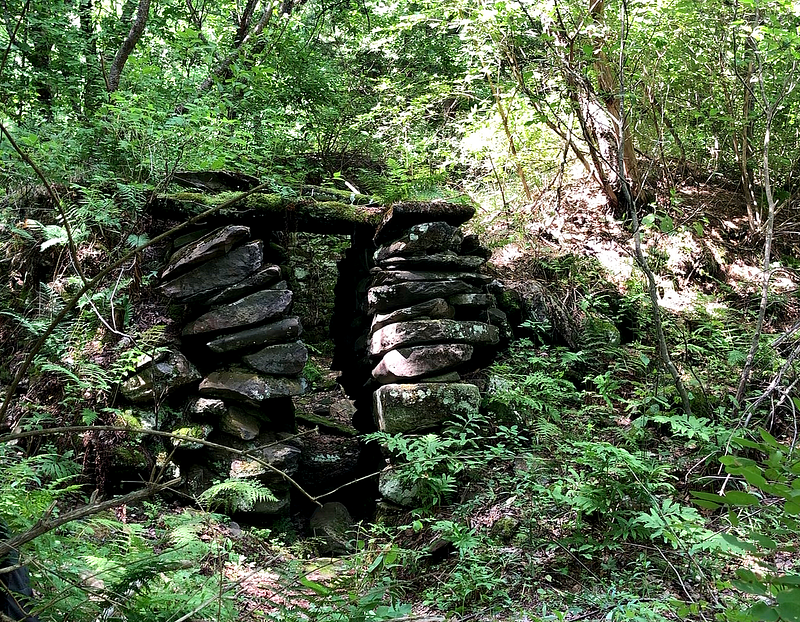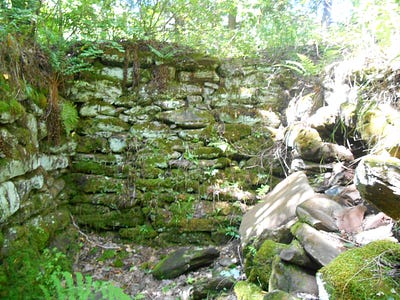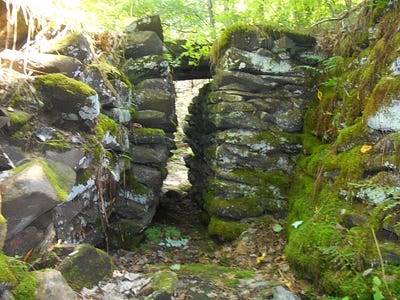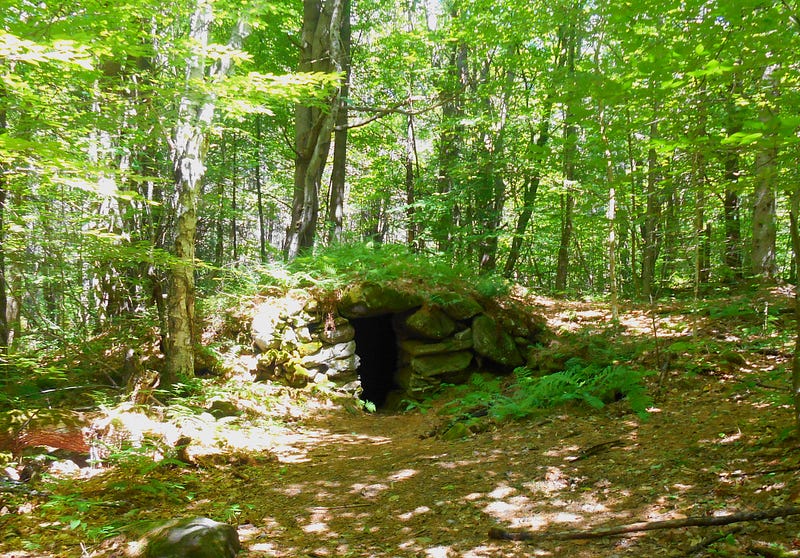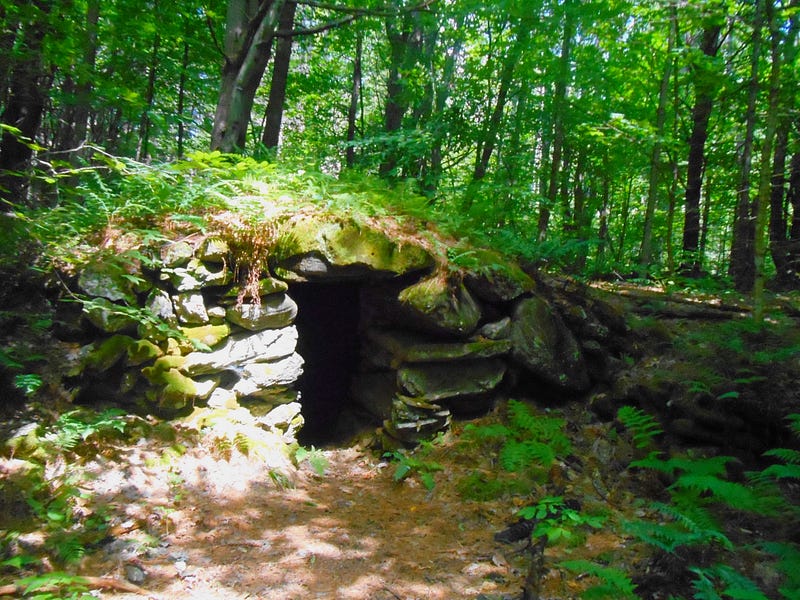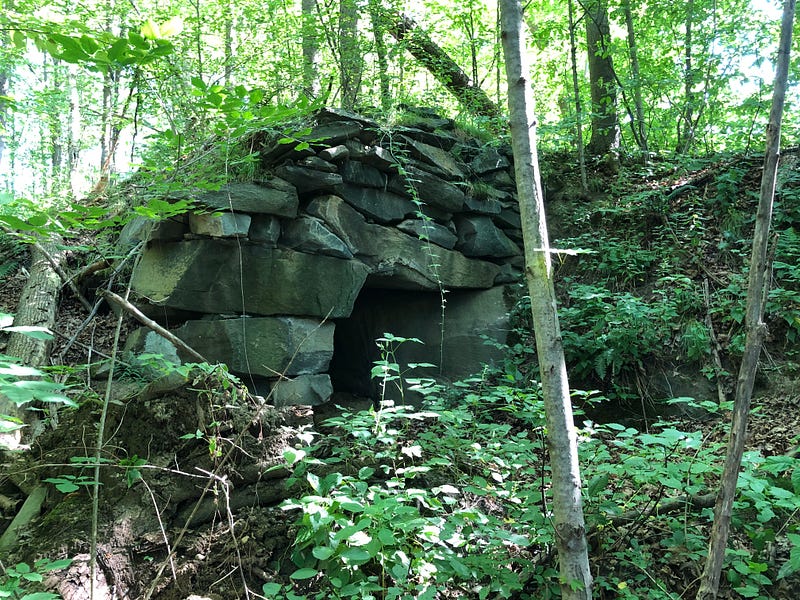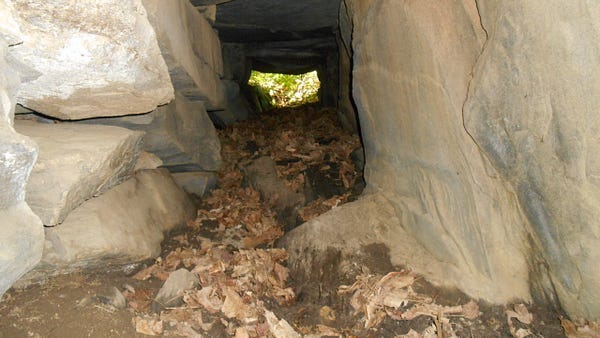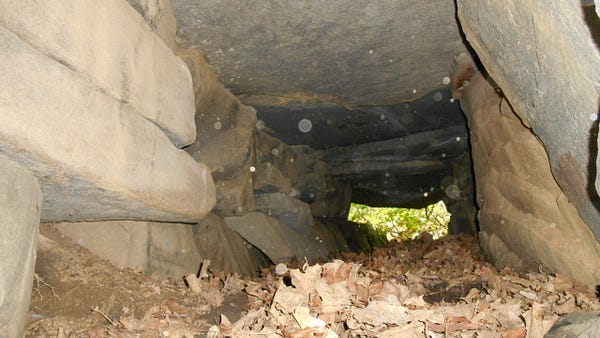An Excerpt from Ancient Stone Mysteries of New England
Author’s Note: My new book Ancient Stone Mysteries of New England is now out in paperback and I’m celebrating by sharing a bit of the book. This abridged excerpt is from an early chapter, edited for an article’s focus and for clarity. Note that in the paperback the photos are in black & white — M.L.
VERMONT’S CALENDAR ONE, CALENDAR TWO, EAGLE AND SECRET TUNNEL STONE CHAMBERS
“Did you know there’s a vampire’s heart buried under the Woodstock Green?”
Not an entirely surprising question coming from Joe Citro.
We met up on the steps of the library on the green in Woodstock, Vermont, with plans to visit a nearby stone chamber. COVID seemed to be easing its grip as the summer went along, though we’d later learn that wasn’t really the case. It did allow for some socially distant outdoor interaction to start happening.
Suspense and horror author, and folklorist, Joe — whether he knows, or would admit it — is a Vermont treasure. His shared encyclopedic knowledge of ghosts, haunts, unexplained events, mysterious locations and just plain weird Vermont has now filled several volumes, such as Green Mountain Ghosts, Ghouls & Unsolved Mysteries, Vermont’s Haunts: Tall Tales & True from the Green Mountains, Joe Citro’s Vermont Odditorium and more. His commentaries entertained Vermont Public Radio audiences for years.
At the time we met up, he was re-releasing his debut novel, an expanded anniversary edition of Shadow Child. On the cover? A Vermont Stone Chamber. In Joe’s fictional universe, it may have been the portal to another reality.
As Joe led us to the site of a stone chamber in this reality, the fabled Calendar Two chamber in South Woodstock, we spoke of possible origins for the chamber and of how it’s oriented towards the Winter Solstice, and of other chambers in the area. And of the Official Position.
My research on the stone chambers and other stonework had been eye-opening — it turned out over 700 Stone Chambers had been discovered by 2018, mostly in the Northeast. The place we were, Windsor Country, Vermont, possessed twenty-nine, one of the largest-known concentrations in the country.[i]
I’d also discovered that back in the late 1970’s and early ‘80’s, Vermont was the focus for a showdown on the stone chambers between professional archaeologists and those who said they thought they were pre-Columbian constructs by early European explorers or Indigenous Peoples.
A conference on Ancient Vermont was held in mid-October, 1977 at Castleton State College organized by Warren L. Cook to discuss the possible pre-Columbian origin of the Stone Chambers and the theories of people like Barry Fell, author of America B.C., who thought Celts were exploring here, and had pointed out what he thought were inscriptions in Ogham, an ancient script.
(James) Mavor and (Byron ) Dix (authors of the groundbreaking book MANITOU) were also part of the conference. An old YouTube video is available on the gathering and the ensuing backlash[ii]. The stone chamber Joe and I were heading to, Calendar Two, appears early in the video.
In my research, I’d come across part of the professional response, or backlash. Vermont State Archaeologist Giovanna Neudorfer undertook a study and authored first an article[iii], then a report: Vermont Stone Chambers: An Inquiry into Their Past[iv]. She saw no mystery in New England’s stones, writing, “While there are still many archaeological puzzles in Vermont the stone chambers are not among them.”[v]
When I first read the report, I was surprised at how many different chambers it said there were in the state. I was also surprised at how the report contradicted itself, opening with a quote on how each site should be considered in its individual context, but ending with the seemingly sweeping judgement that they were all the same and mostly served as colonial storage sheds or root cellars. Given the evidence provided, that didn’t seem right.
I was struck by the surprising tone to the report, obviously written at a time when those claims that Celts or other Europeans might have made it to North America pre-Columbus were enjoying their moment in the sun. It was written in many ways to offer a strict, “No, you’re wrong!” polemic against them specifically — with little consideration seemingly given to an Indigenous provenance to the stonework.
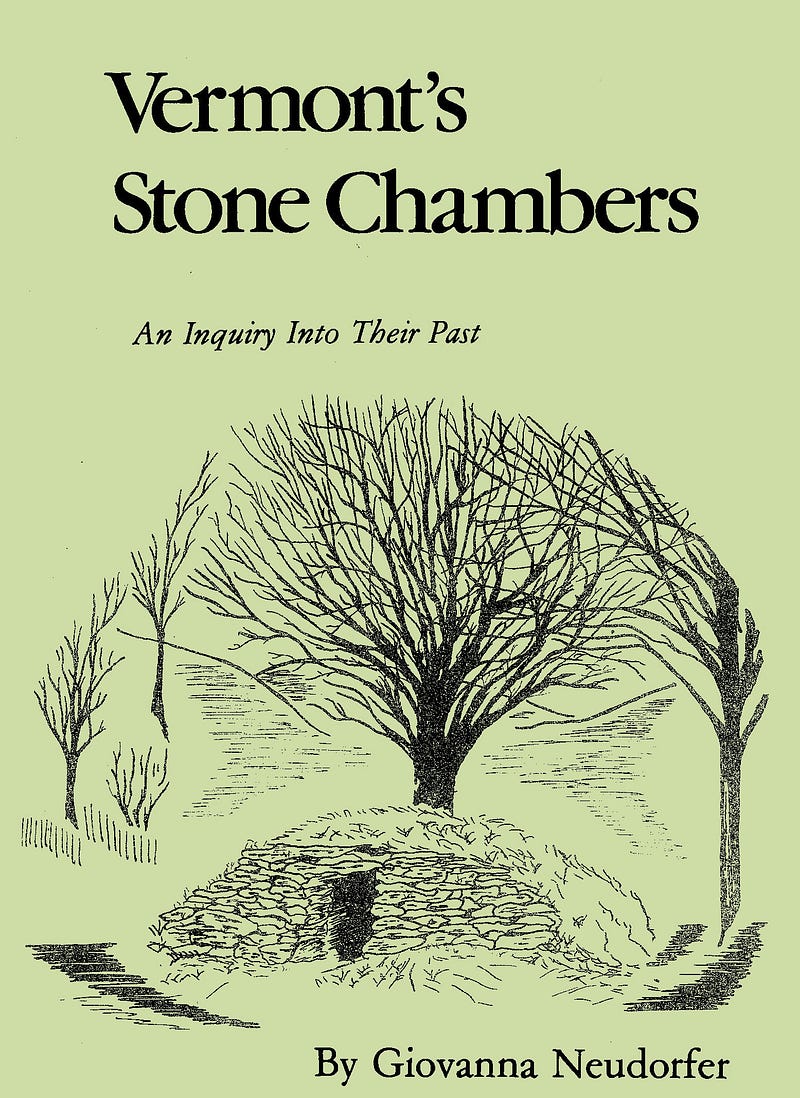
I also discovered Mavor and Dix had responded to her report in the pages of Vermont History: The Proceedings Of The Vermont Historical Society in 1982, seven years before the publication of Manitou, with many of the same thoughts I’d had. They wrote:
Neudorfer states that the “stone chambers must be shown to be architecturally and functionally deviant from the 18th and 19th century farm setting which surrounds them before they can be examined within the setting of inscriptions and standing stones,” and that “the stone chamber must first be demonstrated not to be historic before it can be demonstrated to be anything else. “ This dogmatic position stems from the limited view of the possibilities she states: historical root cellars or prehistoric European structures. She has eliminated the possibility that an indigenous, prehistoric people may have built the structures, a context which our work indicates as at least worthy of consideration.
Broadening the possibilities leads to the logical inversion of Neudorfer’s approach . The historical farm setting can be viewed as deviant from the Indian setting which existed for at least 10,000 years compared with the 200 years of European agricultural experience in Vermont. This approach challenges modem observers to stretch their sights beyond the more obvious and familiar. Over the immense time span from prehistoric to historic period, a stone chamber could have evolved from a place, perhaps sacred, to a temporary structure, to a stone building.[vi]
Forty years later, there are still many anthropologists and archaeologists who believe the chambers are simply colonial root cellars, chimney supports or other historic constructions. They attribute all of New England stone works to colonial farmers clearing fields, or building staging for stone walls, or beautifying their farms to keep their kids from leaving home.
Mavor and Dix named this stone chamber Calendar Two when they discovered you could see sunrise on the Winter Solstice from the chamber. A nearby upright stone is supposed to aid in sighting the alignment, as light from the rising sun reaches the back of the inner chamber. A rounded mound outside, the inside here is neatly squared off. Its dimensions are said to mirror those of the King’s Chamber of the great pyramid, on a smaller scale. By those who say such things.
I made my first “Experiencing…” stonework video after this Calendar Two visit, still available on my YouTube channel. The four-minute video proved popular when I shared it around.
Well, aside from in the Ancient Vermont Facebook Group. The admin there greeted my (video) post with an unexpected hostility and surprisingly banned me from the Group. This would eventually lead to me starting my own Facebook Group. Maybe I should thank them.

On a more positive note, I liked this new Experiencing… video format I’d stumbled on. I’d made and posted a short video after my Day One visits, but now went back, and over the next couple of days made new Experiencing… videos for the Nashoba Brook and Upton Stone Chambers using the earlier footage and applying more recently gleaned knowledge from Manitou and other sources.
Mavor and Dix gave Calendar One its name, too. When you stop and think about it, it’s a testament to their work and its impact that many stone works are still referred to by the names given them by Mavor and Dix.
Calendar Two was cool. But I still wanted to see Calendar One. Calendar Two got a brief mention in Manitou. But Calendar One rated a couple of chapters. It was where they made their discovery the stonework was likely Indigenous work, not pre-Columbian European.
As I re-read the next-to-last chapter of Manitou, Back to Calendar One, an old friend who’d seen my recent Facebook posts on Calendar Two reached out via text message, asking if I wanted to see Calendar One. A friend of his had given him directions. Of course I did!
Keith was Chief Engineer at a radio station I’d worked at in Vermont years ago. We met up at the South Royalton Green, and I met his wife, Janet.
No vampire stories from Keith.
We piled into his car and headed up a couple of back roads to a trailhead, where we parked. Then, we set off to find our way in through the woods to the stone chamber. It was going to be a little bit of a hike. So, we hiked. And hiked. And… we couldn’t find it.
We thought we were following the directions. We found some cool stone rows and possible marker stones, but no chamber. In some ways, it was interesting to wander off the beaten path in Calendar One a little, as we saw stones and such that I would have missed otherwise. We found a stone that may have been one Dix & Mavor called the “North Stone” in the north wall, given the markings (glacial only?), and the fact it looks like the head of a serpent or a dragon.
We walked and found a place where Keith had phone service and he called his friend Jim, who’d originally given him the directions to the stone chamber. Jim came up with his wife and dog and showed all six of us the way to the Calendar One Stone Chamber, which turned out to be just a little bit further on up the trail than we’d gone.
Mavor and Dix spent a lot of time at Calendar One. The name refers to more than just the stone chamber. It encompasses the whole area, the valley around it. They felt astronomical alignments they determined were created in and around this structure, including the use of additional stonework found on surrounding ridges, allowed Indigenous folks to mark days and seasons, so they called it a calendar. Though this is the Calendar One Stone Chamber, the entire bowl-shaped valley was referred to by the authors as “Calendar One.”

The Calendar One Stone Chamber has been missing its roof for a long time. The front left entrance stones are bowed out to the right, creating a bit of a tight squeeze for entry. The right-side interior wall (looking in) has suffered some actual collapse. Yet, it is still an impressive structure. On the beautiful day we hiked in to see it, I could sympathize with those such as Dr. Fell who had thought it some sort of ancient temple.
Mavor and Dix’s radiocarbon dating found this chamber to be 435 to 470 years old, possibly built sometime in the 1500s. Their excavation work at this site led them to believe it was likely Indigenous.
The state archaeologist still insisted this was only a colonial root cellar in that old Vermont study. I have a hard time believing that to be the case, even now.
Granted, the entry stones are bowed in some, but the entryway for this stone chamber strikes me as far too narrow to have been a practical passageway through which to carry in bulk goods. Are they supposed to have passed in the harvest one root at a time?
There are several chambers in this area. After the Calendar One Stone Chamber, Jim showed us down the hill to nearby Eagle Chamber, said to have been built as a storehouse for apples for cider in late colonial days. That may be the case. But to my eyes, Eagle Chamber’s construction style, incorporating the bedrock, makes it seem an even older construction than the Calendar One chamber.
Now, I’m sure these chambers were used in colonial times for food or ice storage or whatever — but what about before that? Later colonial usage doesn’t invalidate earlier possible utility, and in fact, later use might wipe out or obscure any material culture — evidence — of what, if anything, went on before it, as I think we saw with the Nashoba Brook Stone Chamber.
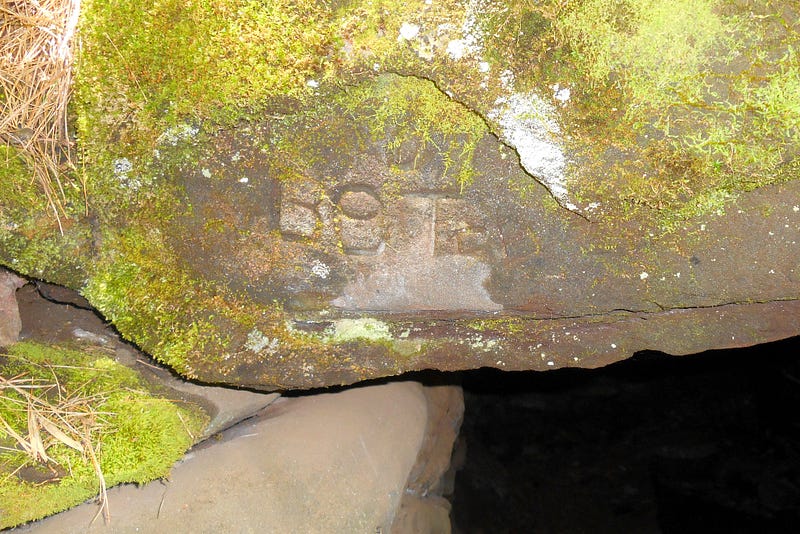
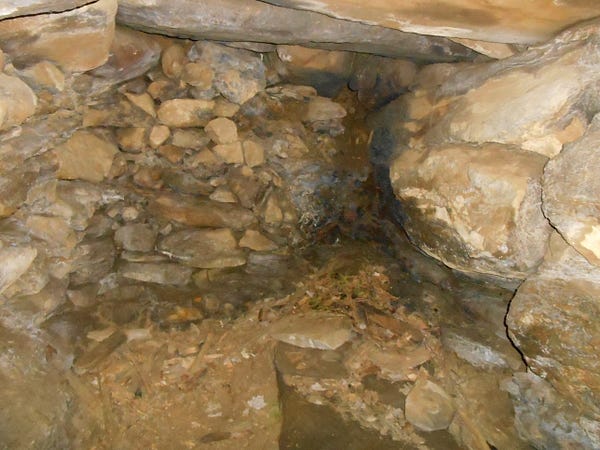
Eagle Stone Chamber appeared constructed in a different style, even a more primitive style, than the Calendar One Stone Chamber. And both of these were different from the Calendar Two, the Nashoba Brook and the Upton Stone Chambers, which were also completely distinct from each other. Each of the five stone chambers I’d visited so far had been built in its own style.
The sixth stone chamber I’d see was also unique — a Tunnel Stone Chamber. Joe Citro hoped to make it up to northwestern Vermont to visit the Tunnel Stone Chamber with me, but circumstances conspired against him. Eventually, he gave me directions and swore me to secrecy. Can’t tell you where it is.
When I first heard about this hidden Tunnel Stone Chamber in a secret location, my thoughts went to ritual tunnels around the world, passages and caves used in rebirth ceremonies and similar rites. Joe said this Tunnel Stone Chamber was near water, which suggested there could be a ritual washing element before a climb up through the tunnel in a rebirth ritual, as is sometimes found. I was intrigued.
With these ideas in mind, I set off to see if I could follow the directions and find this thing.
It was not that far off the beaten path, though it is tucked away. I understood why its location was hush-hush. I descended downhill a little past it, at first. Realized I’d passed it when I turned around and looked uphill — I could see it. The secret, hidden Tunnel Stone Chamber is an impressive structure from below.
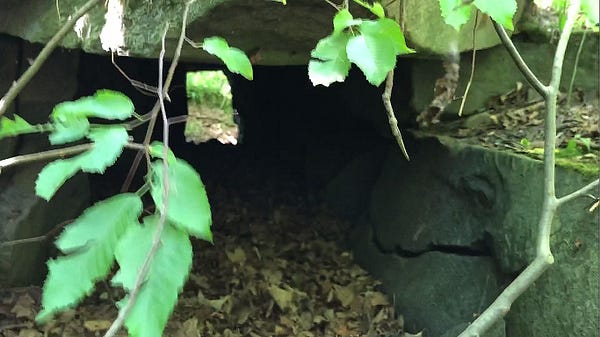
The Tunnel Chamber had some huge stones incorporated in its construction and was built right onto bedrock. It was very clean inside, as if water often washed down through it. The space within narrowed as it rose up the hill, the exit still passable, but it was only just human-sized, and hidden somewhat. From a distance, it was extremely difficult to make out the upper entrance, unlike the impressive lower entrance.
Unfortunately, it may look cooler than it actually is. A source of Joe’s at the state’s highway department later suggested the chamber was an old stone culvert. Some additional research led me to believe he was right, and that it was likely built as part of an old turnpike in the early 19th century. The old road over it was likely washed away in what they call the Great Flood of 1927, around these parts. New roads after that flood were built at a slightly higher elevation, as the current road is here.
That’s my opinion. Joe insists it’s still a mystery.
After my Summer of Stone Chambers, visiting these four stone chambers in July and August, I wouldn’t experience another until early May, when I visited researcher Josh Smart in the Mount Ascutney area. Instead of chambers, in the months ahead I’d see what stonework could be found in public parks and places and spaces around my home in Burlington, Vermont and my childhood home in Hudson, Massachusetts.
Given some time to think about the half-dozen stone chambers I’d seen, it was evident to me — from ancient stones to highway stones — none of these stone chambers was really the same as any of the others. Each was unique, different in its own way. It seemed possible there were different origins for each. The possibly varied backgrounds of the stone chambers in some ways made the stonework even more mysterious. It seemed a mistake to make sweeping generalizations about all stone chambers, as the Vermont State Archaeologist seemed to do in her 1980 study.
Looking into modern scholarship on the chambers, I found NEARA and a few others were continuing to build on the work of Mavor and Dix today. More of these chambers and other stone workings are getting dated, now using OSL or Optically Stimulated Luminescence dating. The early results certainly suggest the stonework is of pre-Contact Indigenous origin.
I attempted to better understand this emerging concept of Indigenous Ceremonial Stone Landscapes (CSLs). Some said the stonework untied earth air and sky, the landscape perhaps “balanced” by rows of stones, perched boulders, and more stone assemblages — the Sacred Landscape seemingly acknowledged by participation with it.
In researching and investigating these stone chambers, I’d learned more and more, not only about the stonework, but also about the forgotten history of New England’s Indigenous peoples. It made me angry, discovering the deep Indigenous history I’d grown up ignorant of, even as I grew up where the post-Contact clash of European Settler and Indigenous cultures went down.
The more I learned, the more I believed that in this stonework, we were seeing the work of indigenous peoples, the ancestors of our Indigenous people of today, and it seemed clear we’d sorely underestimated their abilities, capabilities, aspirations, technology, spirituality — their humanity.
Our European ancestors did us all a disservice as, in general, our histories lied to us as to who the Indigenous Peoples truly were.
Cultural erasure, genocide, ethnic cleansing — despite all of those, when I stopped and really listened to the stones? They were still telling their stories, the stories of New England’s Indigenous Peoples.
And they seemed to encourage me to tell their stories as well.
RELATED VIDEOS
Experiencing Calendar I and Eagle Chambers
Experiencing the Unique Tunnel Chamber and More
Up Through the Hidden Tunnel Chamber
This is an abridged and excerpted chapter — with images in full color — from the much longer Ancient Stone Mysteries of New England: Discovering Ancient History All Around Us by Mike Luoma, with over 500 Black and White photographs, available now in paperback. Learn more at http://AncientStoneMysteries.com.
ENDNOTES
[i] Hoffman, Curtiss, Stone Prayers (2018), p. 89.
[ii] Ancient Vermont video (https://youtu.be/m4WTr351JlY).
[iii] Vermont History: The Proceedings Of The Vermont Historical Society, Vol. 47, №2. (Spring 1979), 79–147.
[iv] Vermont Stone Chambers: An Inquiry into Their Past, Neudorfer, Giovanna, (Montpelier: Vermont Historical Society, 1980).
[v] Neudorfer, p. 61.
[vi] Dix, Byron E. and Mavor, James W. Jr., Vermont History: The Proceedings Of The Vermont Historical Society, Vol. 50, №3. (Summer 1982), p 182.
Links to books, videos & more from Mike Luoma & Glow-in-the-Dark Radio at https://MikeLuoma.com or https://glowinthedarkradio.com.





